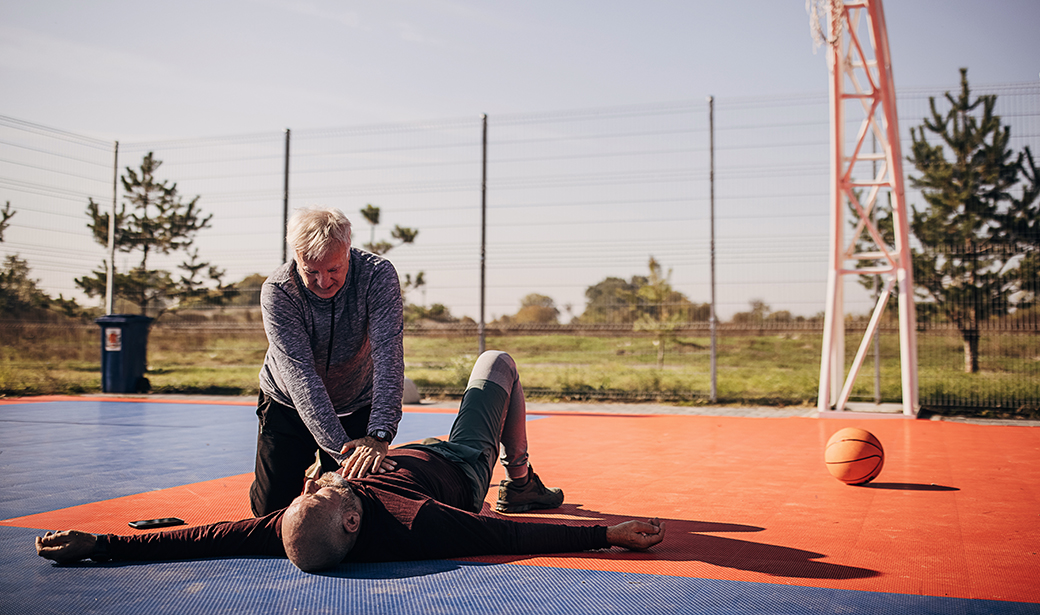When it comes to heart conditions, most people think of heart attacks and the common risk factors, such as high blood pressure, obesity and lack of activity. So why then, do perfectly healthy people — from professional athletes to weekend warriors to high school students — suddenly go into cardiac arrest?
To answer that question, we first need to define what a cardiac arrest is.
Explaining Cardiac Arrests
Sudden cardiac arrest (SCA) isn’t the same thing as a heart attack, which happens when blood flow is blocked in the heart. Instead, during SCA, your heart gets out of rhythm or stops beating because the heart is pumping too fast or the four chambers aren’t coordinated in their contractions, also called an arrhythmia.
Without a regular heart rhythm, we stop breathing and lose consciousness. It goes without saying, SCA is an emergency: It is fatal if not treated within minutes with CPR or an automatic external defibrillator (AED).
“The data shows that cardiac arrests outside of a hospital have a high mortality rate,” said Arun Kumar, MD, an interventional cardiologist at MU Health Care. “When the heart is not beating, you're not getting blood flow to your vital organs, including your brain. Early CPR, early defibrillation, if needed, keeps the heart going until EMS or other medical providers who can provide more advanced care arrive.”
Causes of Cardiac Arrest
Though rare, SCA happens because of underlying conditions that go unnoticed by otherwise healthy people. It’s one reason most high school sports require annual physicals for participation, though SCA can occur in any age group.
“Some people have underlying health conditions that might not show symptoms, so they feel they are in great health,” Kumar said. “But there may be underlying risk factors out of view that could put an individual at risk for sudden cardiac arrest.
SCA can happen due to inherited (genetic) or present from birth (congenital) reasons. It can also result from accumulated risk factors such as smoking, high blood pressure, high cholesterol and other conditions that can make the heart susceptible to a dangerous heart rhythm. Some causes are unknown, and not everyone experiences symptoms before an episode. SCA can happen during stressful activities such as exercise, but it can also occur when the heart is at rest or during sleep.
Conditions including cardiomyopathy, coronary artery defects, high blood pressure, primary arrhythmias such as ventricular fibrillation, and diseases like coronary artery disease and heart disease, can all cause or contribute to SCA.
Symptoms
Some people experience SCA without symptoms, but the condition is recognizable because it causes:
- Sudden collapse.
- No pulse or breathing.
- Loss of consciousness.
Others have described symptoms leading up to attacks including:
- Fatigue or weakness.
- Shortness of breath.
- Chest pain or discomfort.
- Fast-beating, fluttering or pounding heart rhythms, called palpitations.
For some, including younger, more physically active people, symptoms may feel similar to strenuous exercise.
Am I at Risk?
If you or someone in your immediate family has a history of heart problems or experiences a sudden cardiac arrest, it’s important to talk to your primary care doctor. Simple blood testing can help you and your doctor understand your risk.
“There are certain genetic mutations that put individuals at risk for things like cardiomyopathy or low heart pump function that can lead to arrhythmias,” Kumar said. “We have tests to make sure that those genetics have not been passed on and that otherwise healthy people aren’t at risk in the future.”
Heart conditions such as risk of developing SCA can be diagnosed with a heart ultrasound (echocardiogram) or an electrocardiogram (EKG), which records your heart’s electrical signals. For adolescents, regular well-child checkups and sports physicals can help uncover heart issues before a medical emergency.
How to Prevent Cardiac Arrest
Because most people who experience SCA do not know they are at risk, it is difficult to prevent. Scheduling annual checkups and talking about your potential risk with your doctor is a great place to begin. Some actions, like quitting smoking and drinking, regular exercise and eating a healthy diet can lower your overall risk of heart conditions.
Learning how to perform CPR and use an AED, or advocate for one in your workplace, can also help those around you. MU Health Care offers free hands-only CPR training sessions through its Save MO Hearts program. CPR is one of the best ways to increase someone's chances of surviving SCA.
“It is important to have a preventative strategy: See a primary care doctor and have your risk factors evaluated,” Kumar said. “This could uncover health conditions you might otherwise not be aware exist. It's also very important that we educate the community on how to do good CPR so that we can help someone who goes down and that defibrillators are available in the community.”



